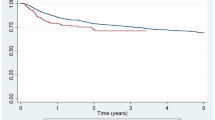Abstract
Clinical and laboratory factors influencing the discontinuation of second-line antirheumatic drugs were prospectively studied using survival analysis in a consecutive series of 245 patients with recently diagnosed rheumatoid arthritis. A statistically significant influence of age, sex, serum IgA and HLA-DR3 on the discontinuation rate of chrysotherapy because of toxicity was observed. The discontinuation of sulfasalazine was increased by advanced age and high rank order of prescription. With respect to efficacy, high initial disease activity appeared to predispose to treatment termination of hydroxychloroquine, sulfasalazine and penicillamine. Furthermore, an influence of the rank order of prescription on discontinuation of sulfasalazine therapy because of lack of efficacy was found. Of interest is that discontinuation of hydroxychloroquine therapy because of lack of efficacy occurred less frequently in HLA-DR3-positive than in HLA-DR3-negative patients. Although these prognostic factors are of secondary importance in clinical practice, they may be of significance in the interpretation and comparison of clinical trials.
Similar content being viewed by others
References
Situnayake RD, Grindulis KA, McConkey B. Long-term treatment of rheumatoid arthritis with sulfasalazine, gold or penicillamine: a comparison using life-table methods. Ann Rheum Dis 1987;46:177–83.
Sambrook PN, Browne CD, Champion GD, Day RO, Vallance JB, Warwick N. Terminations of treatment with gold sodium thiomalate in rheumatoid arthritis. J Rheumatol 1982;9:932–4.
Grindulis KA, McConkey B. Outcome of attempts to treat rheumatoid arthritis with gold, penicillamine, sulphasalazine or dapsone. Ann Rheum Dis 1984;43:398–401.
Thompson PW, Kirwan JR, Barnes CG. Practical results of treatment with disease-modifying antirheumatic drugs. Br J Rheumatol 1985;24:167–75.
Husain Z, Runge LA. Treatment complications of rheumatoid arthritis with gold, hydroxychloroquine,d-penicillamine, and levamisole. J Rheumatol 1980;7:825–30.
Harth M, Davis P, Thompson JM, Menard H, Beaudet F. Comparison between sodium aurothiomalate and auranofin in rheumatoid arthritis. Scand J Rheum 1987;16:177–84.
Van Riel PLCM, Reekers P, Van de Putte LBA, Gribnau FWJ. Association of HLA antigens, toxic reactions and therapeutic response to auranofin and aurothioglucose in patients with rheumatoid arthritis. Tissue Antigens 1983;22:194–9.
Wijnands MJH, Van Riel PL, Gribnau FW, Van de Putte LB. Risk factors of second-line antirheumatic drugs in rheumatoid arthritis. Semin Arthritis Rheum 1990;19:337–52.
Ropes MW, Bennett GA, Cobb S, Jacox R, Jessar R. 1958 revision of diagnostic criteria for rheumatoid arthritis. Bull Rheum Dis 1958;9:175–6.
Ritchie DM, Boyle JA, Mclnnes JM, Jasani MK, Dalcos TG, Grieveson P, et al. Clinical studies with an articular index for the assessment of joint tenderness in patients with rheumatoid arthritis. Q J Med 1968;147:393–406.
Van der Heijde DMFM, Van 't Hof MA, Van Riel PLCM, Van Leeuwen MA, Van Rijswijk MH, Van de Putte LBA. Judging disease activity in clinical practice in rheumatoid arthritis: first step in the development of a disease activity score. Ann Rheum Dis 1990;49:916–20.
Van der Heijde DMFM, Van 't Hof MA, Van Riel PLCM, Van Leeuwen MA, Van Rijswijk MH, Van de Putte LBA. Validity of single variables and composite indices for measuring disease activity in rheumatoid arthritis. Ann Rheum Dis 1992; 51:177–81.
Naranjo CA, Busto U, Sellers EM, Sandor P, Ruiz I, Roberts EA, et al. A method for estimating the probability of adverse drug reactions. Clin Pharmacol Ther 1981;30:239–45.
Wijnands MJH, Van 't Hof MA, Van Leeuwen MA, Van Rijswijk MH, Van de Putte LBA, Van Riel PLCM. Long-term second-line treatment: a prospective drug survival study. Br J Rheumatol 1992;31:253–8.
Stephens MDB. The diagnosis of adverse medical events associated with drug treatment. Adv Drug React Ac Pois Rev 1987;1:1–35.
De Bosset Ph, Bitter T. Factors governing safety and success of gold salt therapy in rheumatoid arthritis (RA). A prospective study. Ann Rheum Dis 1975;34:196.
Oka M, Kytilä J. Rheumatoid arthritis with the onset in old age. Acta Rheumatol Scand 1957;3:249–58.
Kean WF, Bellamy N, Brooks PM. Gold therapy in the elderly rheumatoid arthritis patients. Arthritis Rheum 1983;26:705–11.
Pullar T, Hunter JA, Capell HA. Toxicity of sulphasalazine in patients with rheumatoid arthritis. Br J Rheumatol 1985;24:214.
Delamere JP, Grindulis KA, Farr M. Effects of rheumatoid activity on drug-induced changes in serum immunoglobulins, particularly selective IgA deficiency. Ann Rheum Dis 1983;42:231.
Farr M, Struthers GR, Scott DGI, Bacon PA. Fenclofenac-induced selective IgA deficiency in rheumatoid arthritis. Br J Rheumatol 1985;24:367–9.
Van Riel PLCM, Van de Putte LBA, Gribnau FWJ, De Waal RMW. Serum IgA and gold-induced toxic effects in patients with rheumatoid arthritis. Arch Intern Med 1984; 144:1401–3.
Harvey C, Dixon JS, Bird HA. Serum IgA concentration and hepatotoxicity in rheumatoid arthritis treated with azathioprine. BMJ 1983;287:534.
Ferraccioli GF, Nervetti A, Mercadanti M, Cavalieri F. Serum IgA levels and ANA behaviour in rheumatoid patients with and without toxicity to remission-inducing drugs. Clin Exp Rheumatol 1986;4:217–20.
Jalava S, Luukkainen R, Hämeenkorpi R, Helve T, Isomäki H. Some characteristics of RA patients with and without side effects due to gold treatment. Scand J Rheumatol 1977;6:206–8.
Ostuni PA, Simioni M, Marson P, Travaglia P, Volante D, Gambari PF. Serum IgA and gold toxicity in rheumatoid arthritis: lack of predicting value. Clin Exp Rheumatol 1986;4:359–62.
Situnayake RD, McConkey B. Clinical and laboratory effects of prolonged therapy with sulfasalazine, gold or penicillamine: the effects of disease duration on treatment response. J Rheumatol 1990;17:1268–73.
Nuver-Zwart IH, Van Riel PL, Van de Putte LB, Gribnau FW. A double blind comparative study of sulphasalazine and hydroxychloroquine in rheumatoid arthritis: evidence of an earlier effect of sulphasalazine. Ann Rheum Dis 1989;48:389–95.
Capell HA, Pullar T, Hunter JA. Comparison of white blood cell dyscrasias during sulphasalazine therapy of rheumatoid arthritis and inflammatory bowel disease. Drugs 1986;32(1 Suppl):44–8.
Jones E, Verrier Jones J, Woodbury JFL. Response to sulfasalazine in rheumatoid arthritis: life table analysis of a 5-year followup. J Rheumatol 1991;18:195–8.
Author information
Authors and Affiliations
Rights and permissions
About this article
Cite this article
Wijnands, M.J., Van 't Hof, M.A., Van Leeuwen, M.A. et al. A prospective analysis of risk factors for the discontinuation of second-line antirheumatic drugs. Pharm World Sci 15, 203–207 (1993). https://doi.org/10.1007/BF01880627
Accepted:
Issue Date:
DOI: https://doi.org/10.1007/BF01880627




